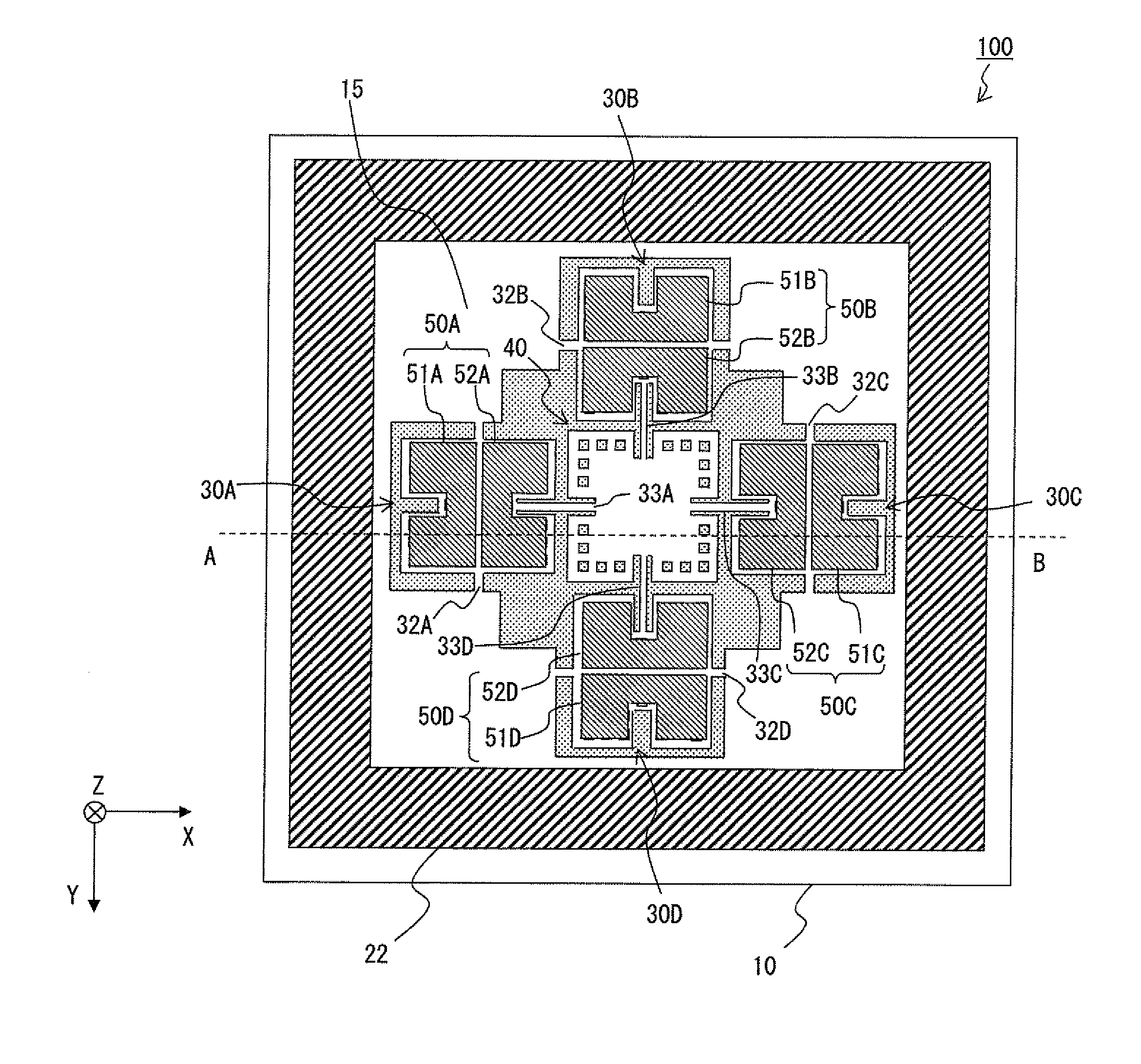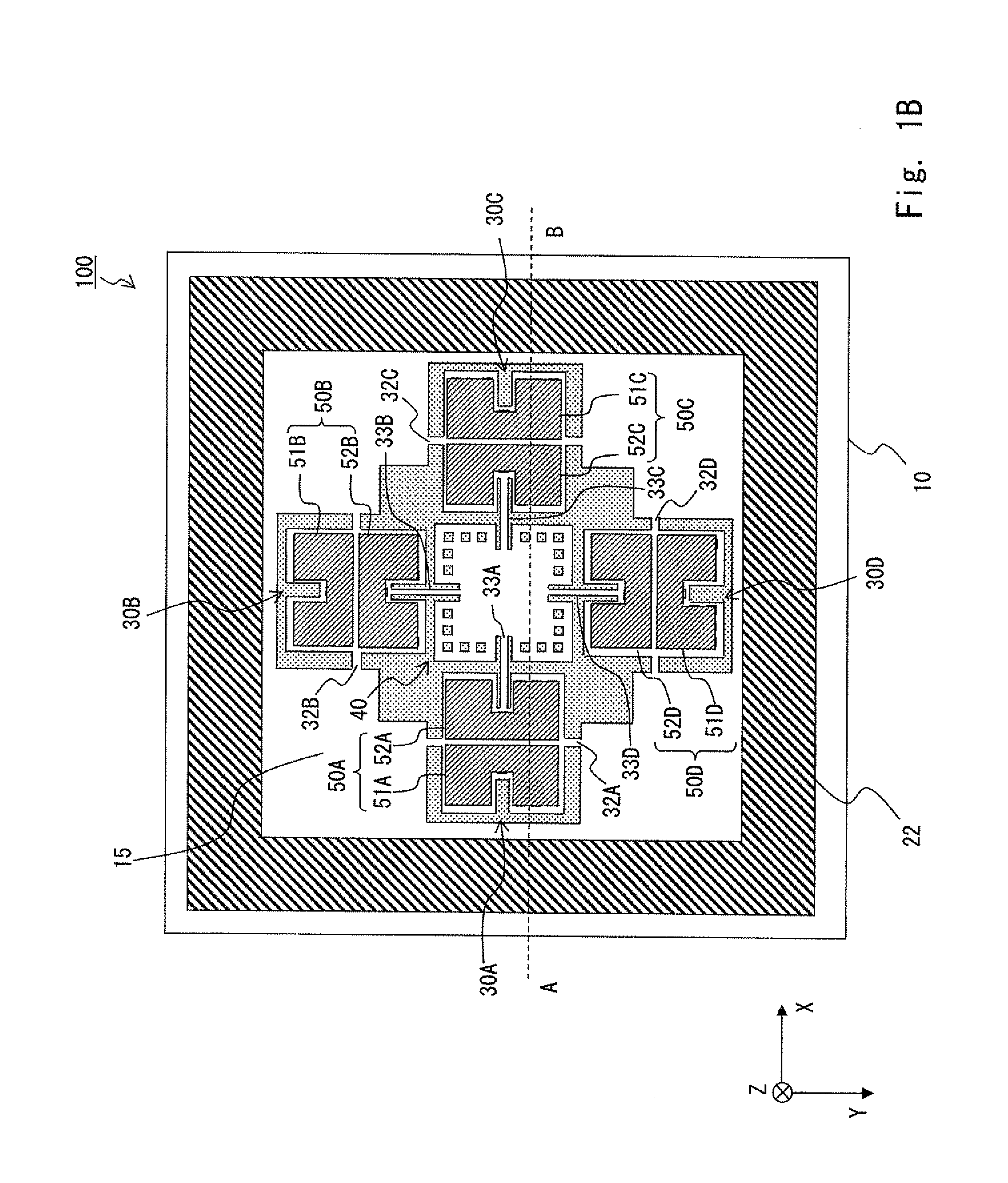Dynamic quantity sensor and dynamic quantity sensor system
a sensor system and dynamic quantity technology, applied in the direction of acceleration measurement in multiple dimensions, instruments, force/torque/work measurement, etc., can solve the problems of low detection accuracy, etc., and achieve low detection accuracy, poor linearity of outputs, and low detection accuracy.
- Summary
- Abstract
- Description
- Claims
- Application Information
AI Technical Summary
Benefits of technology
Problems solved by technology
Method used
Image
Examples
embodiment 1
[0063]Hereinafter, an embodiment 1 will be explained with reference to the drawings. The embodiment is an example of a force sensor that detects a force, which is one of dynamic quantity, by triple axes as a multiaxial dynamic quantity sensor. The triaxial force sensor can detect forces in an X direction, a Y direction, and a Z direction. FIG. 1A is a top view of a force sensor 100 pertaining to an embodiment of the present invention. FIG. 1B is a perspective view of a bottom surface of the force sensor 100 in which a sealing substrate has been omitted. FIG. 1C is a perspective view of the bottom surface of the force sensor 100 in which the sealing substrate and a fixed electrode have been omitted. FIG. 1D is a cross-sectional side view taken along a line A-B of the force sensor 100 in FIG. 1A.
[0064]As shown in FIGS. 1A to 1D, the force sensor 100 pertaining to the embodiment is provided with a movable support portion 10 and a sealing portion 20, and the movable support portion 10 a...
embodiment 2
[0126]Hereinafter, an embodiment 2 will be explained with reference to the drawings. The embodiment is an example where the force sensor includes only a movable support portion with respect to the embodiment 1. FIG. 6A is a top view of the force sensor 100 pertaining to the embodiment. FIG. 6B is a cross-sectional side view taken along the line A-B of the force sensor 100 in FIG. 6A.
[0127]As shown in FIGS. 6A and 6B, the force sensor 100 according to the embodiment does not have a sealing portion, but is provided with only the movable support portion 10. In addition, since a force is applied from a side (main surface side) on which a force receiving portion and a seesaw portion are arranged, a force applying direction (orientation of the Z direction) is opposite as compared with the embodiment 1.
[0128]The movable support portion 10 is mainly provided with the seesaw portions 30A to 30D, the force receiving portion 40, and the fixed electrode pairs 50A to 50D, and is not provided wit...
embodiment 3
[0136]Hereinafter, an embodiment 3 will be explained with reference to the drawings. The embodiment is an example where the force sensor includes three seesaw portions with respect to the embodiment 2. FIG. 8A is a top view of the force sensor 100 pertaining to the embodiment. FIG. 8B is a cross-sectional side view taken along the line A-B of the force sensor 100 in FIG. 8A.
[0137]As shown in FIGS. 8A and 8B, the force sensor 100 according to the embodiment is provided with only the movable support portion 10 similarly to the embodiment 2. The movable support portion 10 is mainly provided with the seesaw portions 30A to 30C, the force receiving portion 40, and the fixed electrode pairs 50A to 50C. The movable support portion 10 is provided with the first silicon layer 11, the insulator film 12, and the second silicon layer 13. At the second silicon layer 13, the force receiving portion 40 is formed in a center, and the three seesaw portions 30A to 30C are formed around the force rece...
PUM
| Property | Measurement | Unit |
|---|---|---|
| force | aaaaa | aaaaa |
| flexible | aaaaa | aaaaa |
| thickness | aaaaa | aaaaa |
Abstract
Description
Claims
Application Information
 Login to View More
Login to View More - R&D
- Intellectual Property
- Life Sciences
- Materials
- Tech Scout
- Unparalleled Data Quality
- Higher Quality Content
- 60% Fewer Hallucinations
Browse by: Latest US Patents, China's latest patents, Technical Efficacy Thesaurus, Application Domain, Technology Topic, Popular Technical Reports.
© 2025 PatSnap. All rights reserved.Legal|Privacy policy|Modern Slavery Act Transparency Statement|Sitemap|About US| Contact US: help@patsnap.com



